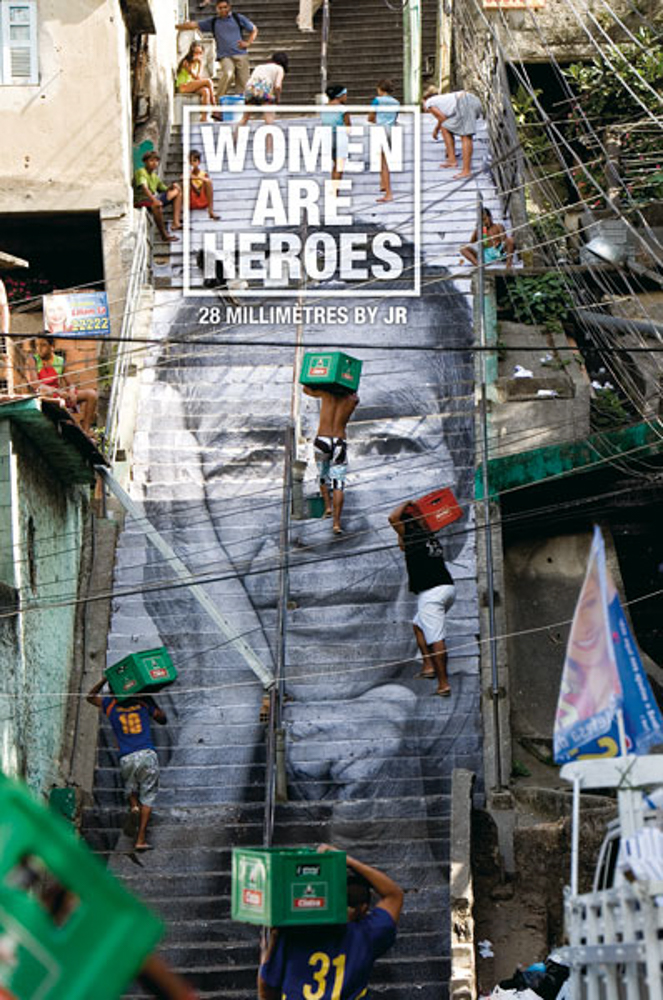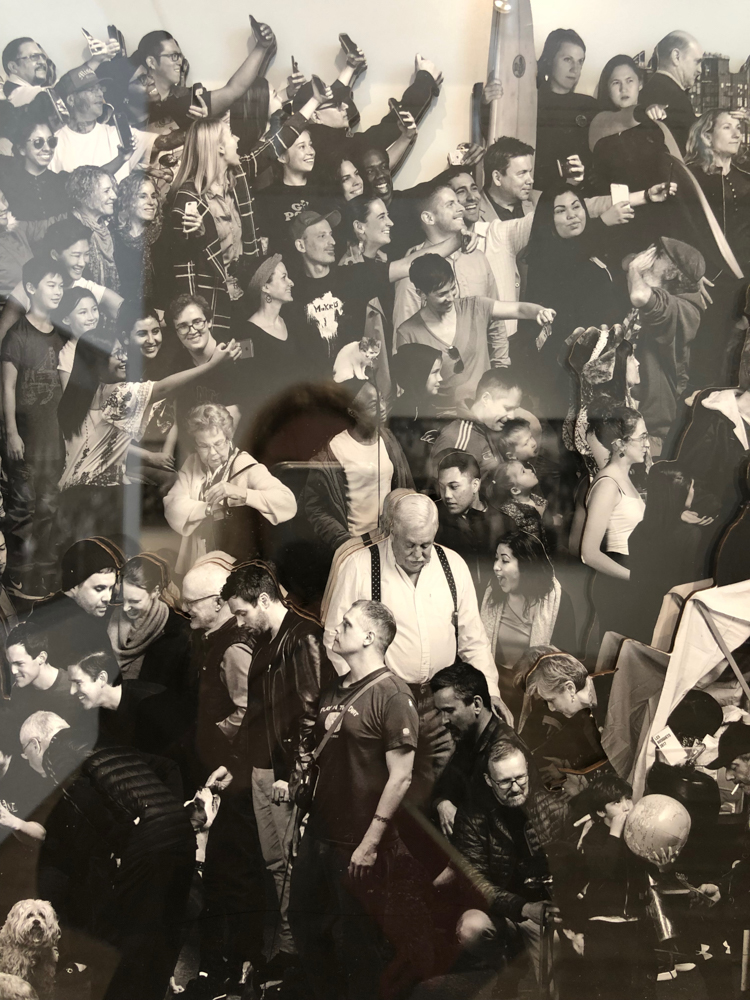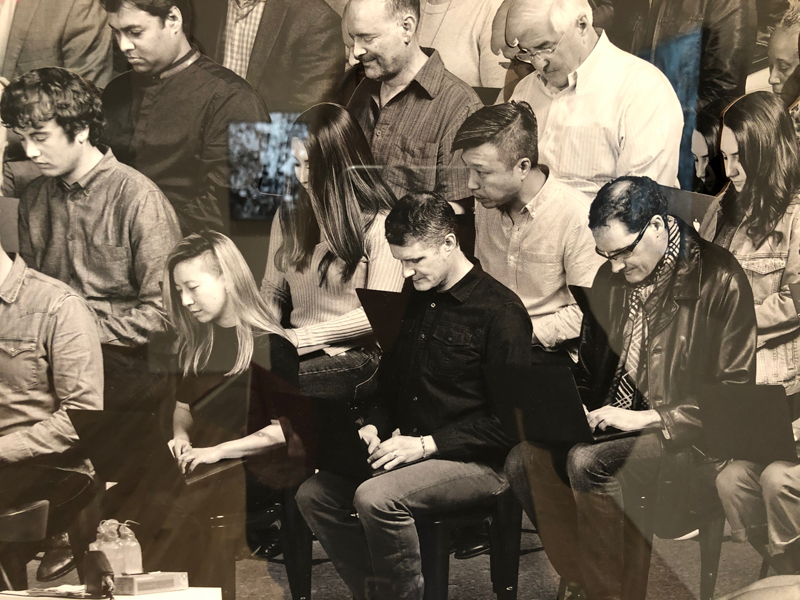Whitehot Magazine
April 2024
"The Best Art In The World"
"The Best Art In The World"
April 2024
Artist JR opens the door to a new era in art history with his groundbreaking “Chronicles of San Francisco” mural at the SFMOMA
 Fig 0. JR, The Chronicles of San Francisco by JR, 2019 (Partial view), (Source: Jr-art.net)
Fig 0. JR, The Chronicles of San Francisco by JR, 2019 (Partial view), (Source: Jr-art.net)
By MELANIE DESLIENS FLINT, June 2019
New technological advancements can have dramatic effects on society which can be analyzed through art history. While populations greatly benefit from these fast-forwarding shifts, they can also create “left behinds” and alienation for a category of the society. Isolation has been observed by artists as a consequence of the first Industrial Revolution which they documented depicting the sadness, sense of immobility and unfairness of the poorest as a result of modernism (central to Realist painters work of the 19th century). Contemporary artists document the effects of new technologies as well but one artist aims at re-connecting people through his art and create an inclusive experience. This French artist with the enigmatic name of JR is one of the most important street artist and activist of the time.
 Fig 1. Women are Heroes by JR, Rio de Janeiro, 2008 (Source: Jr-art.net)
Fig 1. Women are Heroes by JR, Rio de Janeiro, 2008 (Source: Jr-art.net)
Through his young artistic career (he is 35), JR has created new conversations between borders (Mexico and US), between Paris and its outskirts, between a Mayor and outlaws, between slum mothers in Brazil and media, between countryside and cities, between art and people not exposed to art, between generations … and more (Fig1). In 2018, JR decided to set camp in the heart of a city famous for its tremendous impact on new technologies, its liberalism, and its homelessness: San Francisco. The results of his work, an exceptional mural called JR, The Chronicles of San Francisco will be opening at the SFMOMA on May the 23rd.
This installation is disruptive on a technical level, the mural is actually a video featuring over 1,200 people portrayed moving in slow motion. As if a moving mural was not a technological breakthrough in itself, JR announced that he interviewed each individual and that the visitors will be able to listen and watch them through the use of an application. This will give, for the first time in art history, the sitter a voice. Who hasn’t wished to listen to the Mona Lisa, to hear directly from her whether she is happy, or sad, or sick? to answer those questions that have tormented scholars to this day.
What strikes the audience when viewing The Chronicles of San Francisco (beside its monumental scale, the mural is 120 feet long) is the overwhelming and lively ocean of people descending like a powerful wave over the city. This human wave is made of San Franciscans who volunteered to meet JR in his mobile studio.
 JR, The Chronicles of San Francisco by JR, 2019 (A woman just gave birth, the opening of the narrative). (source: M.Desliens, shot at Pace Gallery Palo Alto)
JR, The Chronicles of San Francisco by JR, 2019 (A woman just gave birth, the opening of the narrative). (source: M.Desliens, shot at Pace Gallery Palo Alto)
The first crowd that could embody the beginning of the narrative or the source of the wave high on the far left is made of a hundred faces, appearing not unlike a school of fish about to pour like water into the city’s first steep street. After channeling through the birth of a baby (birth of the narrative) (Fig2), the wave of humanity is accelerating onto a second scene. The speed of the wave is symbolized by the steep street and a group of runners that create movement and lead the eye towards the right. One of the Victorian houses has caught on fire and firefighters are climbing into smoke, a scene that could represent the turmoil the city faces with numerous homeless paving the bottom of the sea, most looking up in heavy wheelchairs, stuck to the bottom.
 JR, The Chronicles of San Francisco by JR, 2019 (JR portrays himself sweeping the floor). (source: M.Desliens, shot at Pace Gallery Palo Alto)
JR, The Chronicles of San Francisco by JR, 2019 (JR portrays himself sweeping the floor). (source: M.Desliens, shot at Pace Gallery Palo Alto)
The mural can also be read as a symphony, sometimes peaceful sometimes very loud (noisy protestors juxtaposed to a group of quiet huggers). The lyrical aspect is reinforced throughout the mural with numerous instruments and singers. The wave next falls down into an old-fashioned open theatre where artists perform on stage. The scene is highly participative as the audience turns its back to the viewer allowing him/her to enter the scene. This is when JR himself enters the stage with a broom. For the untrained viewer he just appears to sweep the floor (Fig3). However, the core of JR’s art is about pasting pictures on walls with his broom. The artist seems to ask the viewer whether images can be deceitful (is he sweeping floors or pasting art?).
 JR, The Chronicles of San Francisco by JR, 2019 (Writer A. Maupin, in white shirt looking defeated). (source: M.Desliens, shot at Pace Gallery Palo Alto)
JR, The Chronicles of San Francisco by JR, 2019 (Writer A. Maupin, in white shirt looking defeated). (source: M.Desliens, shot at Pace Gallery Palo Alto)
Afterwards, the human river continues its flow to the Golden Gate Bridge which seems to open the door to the modern and progressive aspect of the city (Victorian homes leave room to skyscrapers). It is in this panel that the viewer can identify politicians, engineers, but also the writer and LGBT activist Armistead Maupin, who seems defeated looking down alone in the crowd (Fig. 4), a unicorn (symbol of successful startups but also of fairytales), a famous basketball player etc… this is also where the artist makes a statement on technology creating isolation, showcasing crowds of people fully absorbed on their laptops or taking selfies without connecting to one another (Fig.5).
 JR, The Chronicles of San Francisco by JR, 2019 (Laptops and isolation). (source: M.Desliens, shot at Pace Gallery Palo Alto)
JR, The Chronicles of San Francisco by JR, 2019 (Laptops and isolation). (source: M.Desliens, shot at Pace Gallery Palo Alto)
Finally, the human wave violently crashes onto the last Victorian home (like onto cliff) with everything the city has to offer in term of performance art. This powerful end of the wave (symphony) looks like rumbles which could be caused by an earthquake, maybe the artist’s reminder that the city is always at risk (Fig.6).
 JR, The Chronicles of San Francisco by JR, 2019 (Human wave final crash/earthquake reminder). (source: M.Desliens, shot at Pace Gallery Palo Alto)
JR, The Chronicles of San Francisco by JR, 2019 (Human wave final crash/earthquake reminder). (source: M.Desliens, shot at Pace Gallery Palo Alto)
The artist’s challenge of portraying accurately a city seems to be a success. In this one space, he is able to represent the city various religious communities. In some areas he even seems to ask the viewer if the answer to turmoil is praying or texting? He touched upon love in all its forms (family hugging, gay couple kissing, dog lovers etc…). JR also reflects on the city as a society in what is beautiful and ugly. However, by choosing black and white, all subjects of JR’s artwork are made equal. The Governor for example is not depicted in a larger manner or more colorful than the homeless, no special light effect is shone on him. The audience’s eye will be free to travel around the mural with no such direction. JR also intends to not only unite these two people on the mural but also in real life as they both will be invited and equally celebrated at the opening of the mural.
The artist brilliantly exposes the numerous opportunities the city has to offer (political influence, education, art, youth etc.…) but also its majors challenges, extremes and lack of cohesion. The term “horror vacuii” (fear of empty spaces) comes to mind when looking at the mural, every inch of the mural is overwhelmingly covered with details and the flow of information is such that there is nowhere for the eye to escape. Again, there is a sense of dichotomy in JR’s work, on one hand, the mural is very hopeful and joyful but at the same time it is suffocating, chaotic and at times uncomfortable which could represent what the city is all about today. What remains is that each of the 1,200 individuals were photographed on their own with their physical features (color of skin, age, etc…) and personal beliefs but somehow the artist managed to group them all together in a very harmonious composition as if to say that despite their differences they are all part of a same world, a same city, part of the problem but also part of the solution. WM

Melanie Desliens Flint
Melanie Desliens Flint is a French writer living in San Francisco. She earned Master degrees in Marketing from both French and American universities and managed strategic partnerships for Ubisoft, a leading videogame publisher. She sits on the board of directors of the French-American Cultural Society (FACS) which is committed to preserve the place of artists within our cities and which imagines and supports the “Villa San Francisco” an upcoming art institution in partnership with the French consulate. As a writer, Melanie explores the term “disruptive” in art history and the subject of new technologies in relationship to alienation.
view all articles from this author







